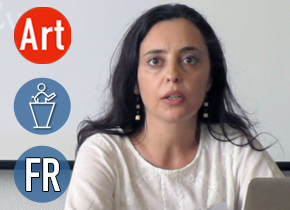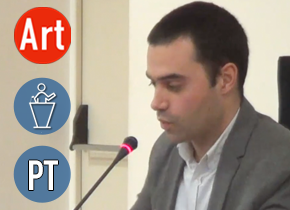Formal and Stylistic Characterization of Portuguese Keyboard Sonatas Published in the 18th Century.
Caractérisation formelle et stylistique des sonates portugaises pour clavier publiées au XVIIIème siècle.
Nejmeddine, Mafalda S.*
*) Centre for the Study of Sociology and Aesthetics of Music (CESEM), Institute for Advanced Studies and Research, University of Évora.
DATES

CITE THIS VIDEO
Nejmeddine, Mafalda S. (2017, June 28-July 1 ). Formal and Stylistic Characterization of Portuguese Keyboard Sonatas Published in the 18th Century [Paper presentation]. 9th European Music Analysis Conference (EuroMAC 9) European Instrumental Music of the 18th Century, Strasbourg, France. https://academy-on.com/videos/nejmeddine-ms-euromac-h-2-2020
SYNOPSIS
Francisco Xavier Baptista, Gomes da Silva and Pedro António Avondano were the only Portuguese composers to have published keyboard sonatas in the 18th century. The formal and stylistic analysis of these sonatas and the comparison with the unpublished sonatas of the same authors suggest that the composition model of the published sonatas was the favorite of the Portuguese society of the time.
Francisco Xavier Baptista, Gomes da Silva et Pedro António Avondano étaient les seuls compositeurs portugais à avoir publié des sonates pour clavier au XVIIIème siècle. L’analyse formelle et stylistique de ces sonates et la comparaison avec les sonates non-publiées des mêmes auteurs suggèrent que le modèle de composition des sonates publiées était le préféré par la société portugaise de l’époque.
ABSTRACT
The importance of the keyboard sonata in Portugal in the second half of the 18th century is confirmed by the appearance of three sonatas publications which are the only Portuguese keyboard works printed throughout this century: Dodeci Sonate, Variazioni, Minuetti per Cembalo by Francisco Xavier Baptista and Sei Sonate per Cembalo by Alberto José Gomes da Silva, published in Lisbon, as well as a sonata composed by Pedro António Avondano and published in London on the title A Favourite Lesson for the Harpsichord. The purpose of this study is (i) to analyze the form and style of these sonatas, (ii) to determine the model of the Portuguese keyboard sonata published, and (iii) to compare, in terms of form and of style, the published sonatas and the unpublished sonatas of these same composers. For that, this study began with the research for the musical sources of the keyboard works of these composers and a biographical research, followed by the elaboration of an analysis grid, from the Sonata Theory of Hepokoski and Darcy, applied to the identified works. The results show that the published sonatas are characterized by a typically galant writing and occur frequently in a model consisting of a cycle of two movements, a fast movement and a minuet, composed in a major key (47.4%). This model differs from the composition models of sonatas that were not intended for the general public. This study allowed to identify the musicological aspect of the Portuguese keyboard sonatas published in the 18th century.
L’importance de la sonate pour clavier au Portugal à la deuxième moitié du XVIIIème siècle est confirmée par l’apparition de trois publications de sonates lesquelles constituent les seules œuvres portugaises pour clavier imprimées durant tout ce siècle: Dodeci Sonate, Variazioni, Minuetti per Cembalo de Francisco Xavier Baptista et Sei Sonate per Cembalo d’Alberto José Gomes da Silva, publiées à Lisbonne, ainsi qu’une sonate composée par Pedro António Avondano et publiée à Londres sur le titre A Favourite Lesson for the Harpsichord. L’objectif de cette étude est (i) d’analyser la forme et le style de ces sonates, (ii) de déterminer le modèle de la sonate portugaise pour clavier publiée, et (iii) de comparer, au niveau de la forme et du style, les sonates publiées et les sonates non-publiées de ces mêmes compositeurs. Pour cela, cette étude a débuté par la recherche des sources musicales des œuvres pour clavier de ces compositeurs et une recherche biographique, suivie de l’élaboration d’une grille d’analyse, à partir de la Théorie de la Sonate de Hepokoski et Darcy, appliquée aux œuvres identifiées. Les résultats montrent que les sonates publiées sont caractérisées par une écriture typiquement galante et se présentent fréquemment dans un modèle constitué par un cycle de deux mouvements, un mouvement rapide et un menuet, composé dans une tonalité majeur (47,4%). Ce modèle se distingue des modèles de composition des sonates qui n’étaient pas destinées au grand public. Cette étude a permit d’identifier l’aspect musicologique des sonates portugaises pour clavier publiées au XVIIIème siècle.
KEYWORDS
Form, Early Music, Instrumental Music, Sonate, Style.
Forme, Musique ancienne, Musique instrumentale, Sonate, Style.
ACKNOWLEDGMENTS
This work was supported by FCT (Portuguese Foundation for Science and Technology) through a research grant of the QREN-POPH with joint participation by the European Social Fund and by the Portuguese Ministry of Education and Science. The author is most grateful to the Biblioteca da Ajuda, Biblioteca Nacional de Portugal, British Library board and Bibliothèque nationale de France for allowing the reproduction of images of their manuscripts and editions.
DISCLOSURES
The author certifies that there is no actual or potential conflict of interest in relation to this video article.








